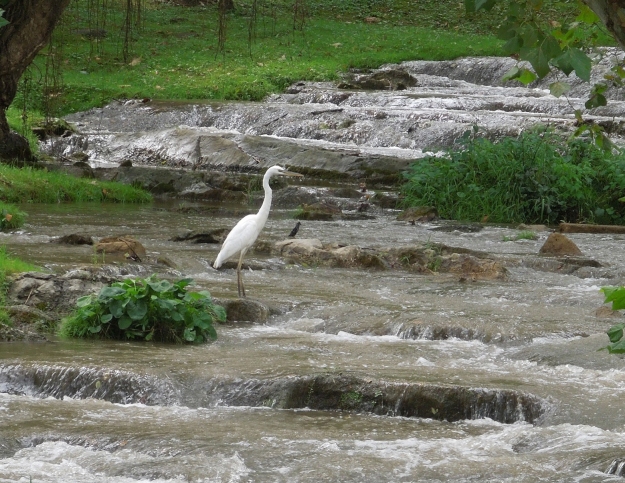I wrote a few weeks ago about the tendency of long-legged wading birds to wander far afield from their usual coastal haunts in late summer. In the ensuing weeks, numerous sightings of some unexpected waders have been reported throughout the region and beyond.
Jeremy Stout, the manager of the Nature Center at Steele Creek Park in Bristol, reported that a great white heron generated some birding excitement among park visitors. Stout noted that the heron was first reported by Sherry Willinger on Monday and Tuesday, Aug. 7-8, and then found again by Ruth and Mary Clark on Friday, Aug. 11. Stout also managed to get a photograph of the heron, which has been seen just outside the park grounds between Ralph Harr Bridge and Highway 126. Steele Creek Park Naturalist Don Holt saw the heron again on Aug. 15. He invited others who see the heron to share their sightings by calling the park’s Nature Center at (423) 989-5616. Reports will help the park staff document the duration of the rare visitor’s stay and keep interested birders informed of its presence.

Photo by Jeremy Stout
This great white heron was photographed near Steele Creek Park in Bristol. Currently considered the same species as the great blue heron, there is debate among experts about granting the great white heron status as a species in its own right.
In early August, Cheryl Livingston reported a great white heron and a great egret at Watauga Lake in Hampton. While only a handful of records exist for the great white heron in this region, these observations will not help boost the lists of any area birders. The great white heron and the great blue heron, scientifically speaking, are the same species — at least for the moment.
According to the website for the U.S. Fish and Wildlife Service, this large wading bird, originally thought to be just a white color morph of the great blue heron, might actually deserve consideration as its own species. The website’s profile of the great white heron notes that recent research about the great white suggests that it is at least a subspecies of the great blue heron. Some preliminary unpublished data suggests that the bird may even be a completely separate species. That would be exciting news for many birders, who would be able to quickly add an unexpected bird to their life lists.
The majestic great white heron usually ranges throughout south Florida and the Florida Keys, but individuals wander far from those parts of the Sunshine State after the nesting season.

Painting by John James Audubon of the iconic Great White Heron of Florida.
The great white heron — as its name suggests — differs dramatically in appearance from a great blue heron, mostly in having all-white plumage. In addition, the great white heron has a yellow bill, which is heavier and more solid than the slender bill of the smaller great egret, for which it could be confused at a casual glance. The great blue heron, known by the scientific named of Ardea herodias, can stand 54 inches tall and weigh close to eight pounds.
Waders other than great white herons have been wandering this summer. Farther afield, Michael Sledjeski has been reporting little blue herons and great egrets at Rankin Bottoms, which is a birding hot spot at Douglas Lake in East Tennessee. The location is well known among birders as a magnet for shorebirds and wading birds. Sightings of wood storks have been somewhat widespread in Tennessee and Virginia this summer.
In addition, other waders are showing up far from their usual ranges. For instance, a roseate spoonbill — a large, pink wading bird — has shown up as far north as Pennsylvania, marking the first time the species has been sighted in the Keystone State since 1968.

Photo by Bryan Stevens • Identifying white herons and egrets can be a tricky business. This immature Little Blue Heron is just starting to get the blue feathers of adulthood.
I’ve not seen anything as exciting as a wood stork or roseate spoonbill at home, but on several occasions in the past couple of weeks my fish pond has been visited by great blue herons. A couple of these visitors were young birds, which are probably wandering widely during their first summer out of the nest. I’ve also seen green herons at the pond and in the creeks along the linear trail in Erwin.
If the great white heron eventually gains recognition as a separate species, I will already have the bird on my Tennessee bird list thanks to a sighting of one several years ago at Musick’s Campground on Holston Lake in Bristol. Ironically, I’ll not have this bird on my Florida list, as I’ve not seen it in its southern stronghold.
••••••
To learn more about birds and other topics from the natural world, friend Stevens on Facebook at https://www.facebook.com/ahoodedwarbler. If you have a question, wish to make a comment or share a sighting, email ahoodedwarbler@aol.com.
